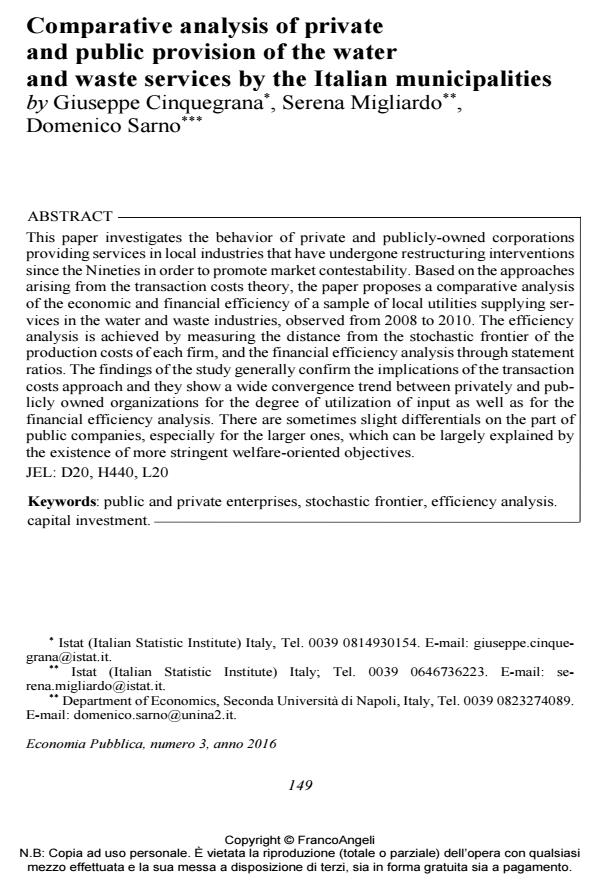Comparative analysis of private and public provision of the water and waste services by the Italian municipalities
Titolo Rivista ECONOMIA PUBBLICA
Autori/Curatori Giuseppe Cinquegrana, Serena Migliardo, Domenico Sarno
Anno di pubblicazione 2017 Fascicolo 2016/3
Lingua Inglese Numero pagine 28 P. 149-176 Dimensione file 303 KB
DOI 10.3280/EP2016-003006
Il DOI è il codice a barre della proprietà intellettuale: per saperne di più
clicca qui
Qui sotto puoi vedere in anteprima la prima pagina di questo articolo.
Se questo articolo ti interessa, lo puoi acquistare (e scaricare in formato pdf) seguendo le facili indicazioni per acquistare il download credit. Acquista Download Credits per scaricare questo Articolo in formato PDF

FrancoAngeli è membro della Publishers International Linking Association, Inc (PILA)associazione indipendente e non profit per facilitare (attraverso i servizi tecnologici implementati da CrossRef.org) l’accesso degli studiosi ai contenuti digitali nelle pubblicazioni professionali e scientifiche
This paper investigates the behavior of private and publicly-owned corporations providing services in local industries that have undergone restructuring interventions since the Nineties in order to promote market contestability. Based on the approaches arising from the transaction costs theory, the paper proposes a comparative analysis of the economic and financial efficiency of a sample of local utilities supplying services in the water and waste industries, observed from 2008 to 2010. The efficiency analysis is achieved by measuring the distance from the stochastic frontier of the production costs of each firm, and the financial efficiency analysis through statement ratios. The findings of the study generally confirm the implications of the transaction costs approach and they show a wide convergence trend between privately and publicly owned organizations for the degree of utilization of input as well as for the financial efficiency analysis. There are sometimes slight differentials on the part of public companies, especially for the larger ones, which can be largely explained by the existence of more stringent welfare-oriented objectives.
Parole chiave:Public and private enterprises, stochastic frontier, efficiency analysis capital investment
Jel codes:D20, H440, L20
- Statistics for Innovation IV Serena Migliardo, Giuseppe Cinquegrana, pp.42 (ISBN:978-3-031-96032-1)
- Rationales, performance and governance of public entreprises. Editorial introduction Luc Bernier, Massimo Florio, Johan Willner, in ECONOMIA PUBBLICA 3/2017 pp.5
DOI: 10.3280/EP2016-003001
Giuseppe Cinquegrana, Serena Migliardo, Domenico Sarno, Comparative analysis of private and public provision of the water and waste services by the Italian municipalities in "ECONOMIA PUBBLICA " 3/2016, pp 149-176, DOI: 10.3280/EP2016-003006